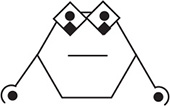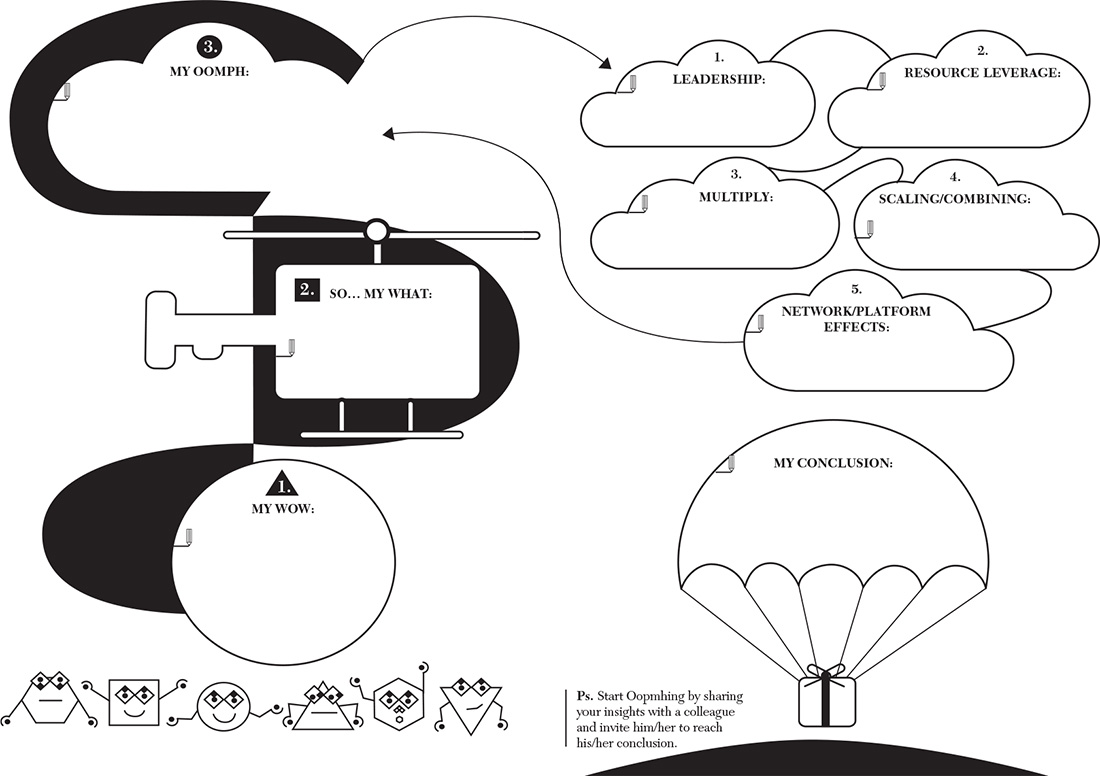3. Workbook: The Strategic Novelty Tools and How to Use Them for Innovating and Amplifying Strategy
To make the journey more productive and perhaps less self-conscious, we have named the tools in such a way that their purpose can easily be remembered and are intuitive to connect with. Humor is a ready accompaniment to strategic novelty, yet it is important to maintain the boundary between a productive laugh and a cynical put-down. Indeed, those who poke fun at novelty are likely to be right in the short-term as, after all, most new ideas fail—at first anyway. However, this short-sighted perspective, more often than not, comes with a fatal limitation of not being open to learning. In the long term such cynicism carries the accountability for shortchanging the organization’s, and hence our society’s, potential for renewal (see Table 3.1).
To guide your journey of discovery, this book develops tools to organize your thinking when faced with outliers and novelty. However, these tools are far from boilerplate strategies and serve as mere guideposts by which to bring back the lessons learned from the leading edge of strategy and potential future best practices, back to your organization. These three tools aim to provoke receptivity to discovery, contextualize relevant lessons from outliers and translate strategic novelty into impactful action.
You may also consult the “Reference Summary on Outliers” for inspiration (you will find it toward the end of this book).
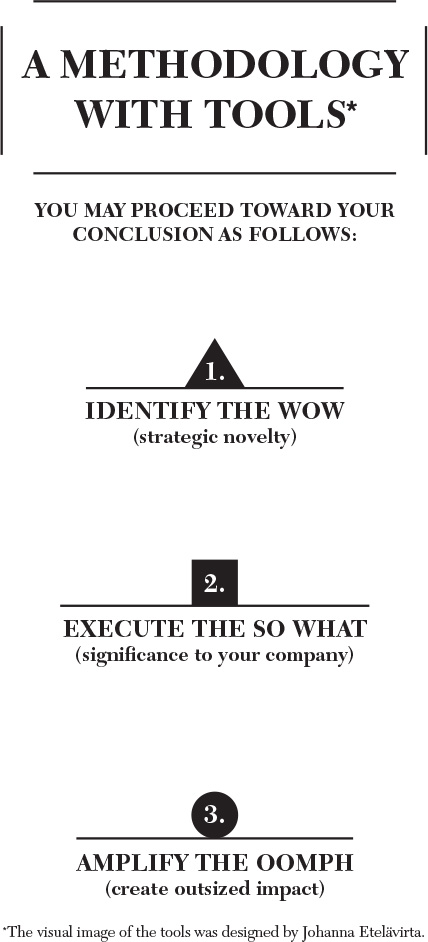
1. WOW!
Are you often surprised these days? If not, we suggest you reboot your perspective. The world has not have stopped innovating even if you or your organization has. In the past, breakthroughs may have come out of closed laboratories or hard to find Silicon Valley garages. However, today through the connectivity of the Internet and an increasingly open culture of innovation, many novel business plans are hiding in plain sight. The relevant question thus becomes what kind of perspective does your organization have toward next strategies and future best practices?
How to develop this perspective? The first step is open up to surprises at the fringes of what you consider the boundaries of your industry. Developing a sensitivity toward noticing the unfamiliar may require a process of becoming attuned to the diversity of organizations typically not captured by generic strategic management tools. The strength of most strategic management tools is the capacity to distill heterogeneous and complex organizations into limited quantitative characteristics in order to homogenize companies making comparative, cross-organizational analysis possible. Outliers, new practices, and strategic novelty often do not fare well in this kind of analysis. Think different, not similar. Rather than focusing on the similar, such as performance indicators and revenue, much can be learned from how companies organize themselves and the business plans hiding behind the numbers.
There are countless ways by which outlier companies can provoke a reaction. If you think that they are too different and their business model will not work, ask yourself Why? Is their business model open and inclusive when the industry norm is closed and proprietary? Is the outlier company too small to be competing in an industry dominated by large incumbent companies? Do the outliers lack the formal qualifications and methods generally deemed necessary to participate in the advancement of science, development of products, or diffusion of ideas? What are the strategic implications for you if these outliers are onto something, or even succeed? How could your organization do something surprising?
2. So What?
Strategic novelty need not be something the world has never seen before. Many instances of invention and novelty have come about through the application of old tools for new purposes or in new or not-yet contexts. While open innovation, new technologies, and inclusive business models are not radically new in and of themselves, they are increasingly being applied in unexpected industries and contexts, with strategic consequence.
Outliers often blend organizational models across industries. For example, social media has emerged as a new industry that has impacted the way humans communicate and interact. Genomera has boldly asked how this technology can be used in a radically different context, medical research. Enabled by technology and spurred on by broad participation, open and inclusive business models are showing up in unexpected places. These same characteristics, technology and openness, are also making these business models visible to those who pay attention. These visible natural business model experiments conducted by Genomera, BioCurious, Organovo, and other outlier companies are a wealth of information, both confirming and challenging existing organizational models as well as the boundaries of relevant industry strategies.
After identifying something unexpected, something outlying, something strategically novel, ask yourself if this outlier organization, or the business model that it is experimenting with, may possibly challenge your company. Particularly if you decide that this particular company is not the one to challenge you, one must ask how your company’s foresight and strategic sensitivity compare with that of your existing competition. For years, Google never thought of Facebook as a competitor. After all, Facebook is in social networking, and Google isn’t—right?
3. OOMPH!
Resistance is one of the signals of potential for OOMPH! “If an innovation does not create a lot of internal resistance, it is not really an innovation” according to a senior executive in one industry-leading company. The founders of a major crowdfunding group note that many incumbent financial firms have moved from fiercely dismissing the potential to wanting to collaborate. Look for points of resistance and keep asking (yourself, to start off with) why those holding onto established practices are so impassionate, dismissive, or perhaps fearful.
To punch above your weight, look first for internal amplifiers. Can you show leadership and thus provide an example for others to follow, like Fondia is doing? Are there resources that can be smartly leveraged, like in Kaggle? Is there a group of internal outliers you could partner with?
IDENTIFY THE WOW: 
This section helps you identify the strategic novelty. You may think about what intrigues or surprises you in the outlier case and why, or why you feel a particular emotion—a joy, relief, anger, frustration, and so on. You may also experience resistance thinking, “this will never work” or “sure, but not for us.”
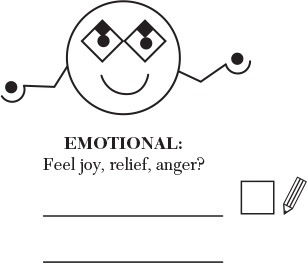

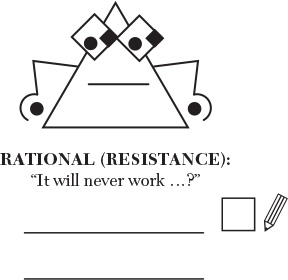
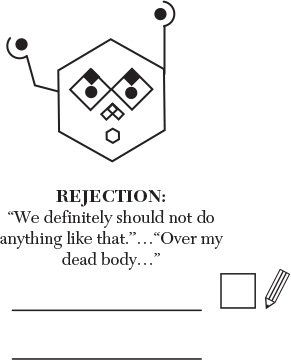
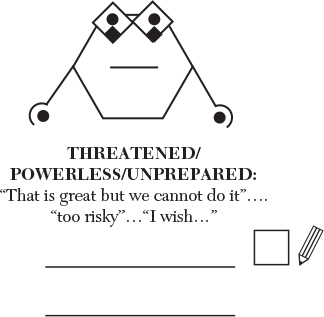

INTRIGUED/SURPRISED/EXCITED:
If you were intrigued or surprised, address the following in your organization:
Goals/Renewal:
How is the intrigue, or the novelty, potentially transformative to your company and industry or geography you operate in?
How should the novelty impact your company goals/lift ambition?
How far into the future do you set your goals?
How much opportunity creation is built into your goals?
How might a competitor take advantage of the novelty to outcompete your company?
Who in the industry is best positioned to benefit from such novelty?
What is your worst nightmare of a competitor?

RATIONAL:
If you felt dismissive, then address the following in your organization:
Culture of action/Rapid learning:
How might you experiment on the novelty in a small way?
How can you use the novelty to improve the culture of action in your company and move from wait-and-see to learning about it?
How can you use the novelty to encourage experimentation?
What would your customers like you to learn?
How do you learn about what customers are likely to want in the future?
What is your internal tolerance for experimentation?

EMOTIONAL:
If you felt joy, relief or anger, or other strong emotion, think about:
Ability to engage:
What does the emotion suggest about your relationship with issues surrounding the novelty?
Does the emotion help you lead or does it slow you down?
How might you be able to turn the emotion into a personal strength and source of growth?
THREATENED/POWERLESS/UNPREPARED:
If you didn’t know what action to take after this feeling, then address following in your organization:
Culture of action/Derisking:
How might you minimize the risks of implementation of novelty in your business?
For example: Develop red teams/act as a devils advocate/hire contrarians to test the incumbent business models/cultivate loyal opposition/avoid group consensus at your own peril.
How quickly would you be able to turn new information into actionable experimentation?
How might you experiment on the novelty in short term (2-6 months) in a small team (4-5 people) with a small or no budget? Build a prototype/engage with lead users/make a trial internally/launch a temporary start-up/ask for passionate volunteers/learn from others.

IN NONSENSE/IRRATIONAL ACTION/FADDISH:
Address the issue of creativity by attaching a performance measure that is aligned with your organization, now and going forward.
Accountability for results/Growth:
How might you use the novelty as a new growth platform?
Who could take charge of the new venture in your organization?
Can you use the new venture to engage intrapreneurs or internal outliers in your organization? Include a measure of “opportunities lost” in the balance sheet?
How would you identify early mover advantage and catalyze small scale experimentation?
How might you benefit from ongoing innovation “despite the system”?
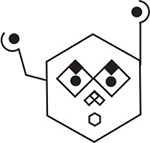
REJECTION:
If you rejected the novelty out of hand, then consider the following:
Who in your organization can renew the company?
Where do your ideas come from? How inclusive are your processes? What is your exposure to new ideas?
How receptive are you to new ideas as an organization?
Where do disruptive ideas come from in your business?
What is your reference group?
What is the pace of your internal renewal? What is your interface with the unknown?
Do you lead or follow?
How viable is your strategy?
(Measures of strategy decay: replicated, supplanted, exhausted, eviscerated, faded away)
If you decided to invest in the culture of action and amplify renewal in your organization, then consider the following. If you rejected the novelty, then start from the beginning with another Outlier case.
Look to the marketplace. Are there possible external amplifiers such as platform or network effects, like Shapeways? Are there available experiments you can learn from and combine for scale, like Quirky? Can you build an architecture where the global apassionata for the cause will join you, like a Robin Hood?
Amplifying may mean that you follow the approach by a senior venture mentor who described his work with start-ups: “I help the founding team to expand their vision 100-fold.” Vision may be one amplifier. There are many others as suggested in the tool accompanying Step 3, in learning from outliers and making their lessons matter for your organization and the world.
How to OOMPH? Use Amplification Strategies!
How do outliers punch above their weight, or achieve outsized impact that is far beyond their size, legitimacy, and resources? They use a number of amplification strategies.
Inclusiveness/Openness
The transition from closed, contained innovation systems toward open ecosystems (Chesbrough, 2003) results in an expanding and wider inclusiveness that can reach increasingly distant outliers (Hoegl et al, 2011). As a consequence, closed platforms will lose hierarchical control over the knowledge that is kept within their systems as well as that which is to be kept out. While open platforms allow many to contribute to open systems they do not mandate participation—just because everyone can contribute doesn’t mean that everyone will. The implications for competition between business models will thus entail structuring organizations and their interactions in a way that is conducive to contribution, further driving openness and inclusiveness. For example, peer-to-peer and commons models are leveraged to transfer and generate knowledge in, and of outliers, in contexts ranging from open source software to the targeting of venture capital investment.
Radical Cost Reductions
Traditionally even the most willing consumers have been excluded from the development process of products simply due to the prohibitive cost of manufacturing technologies. However, the recent radical cost reduction of prototyping machinery (Chua et al, 2010) and even clinical laboratory experiments will have far-reaching implications for the creation and diffusion of knowledge. 3D printing, life-hacking, and reverse innovation, for example, have shifted the knowledge work of engineering and life-science laboratory experimentation from the corporate lab to the Internet and hacker garage, and back—while democratizing the process of innovation (von Hippel, 2005).
Modularization
The value of manufactured products is composed of the integration of the collective parts. However, the increasingly rapid commodification of components is enabling the modularization of products. When combined with the digitization of physical goods through technologies such as 3D printing, the arena becomes open to consumers to develop and refine products. In doing so the control over the knowledge built into consumer products is being increasingly diffused and becomes open to contribution. Furthermore, drawing on the plug and play characteristics of the software and mobile industry, many emerging platform-based business models are becoming reliant on increasingly diverse organizations. Thus, even outliers with specific or narrow knowledge are able to contribute to highly complex ecosystem of modularized products, previously the domain of closed manufacturing.
Massive Search Strategies
Innovation is often a complex problem-solving process that needs to take into account multiple (often conflicting) aspects such as technological and commercial feasibility, design, aesthetics, degree of novelty, and sustainability. How do companies find ideas for growth and renewal? Facing complex settings and high search costs, such organizational search behavior (Katila and Ahuja, 2002; Simon, 1947) will often end in the selection of the closest satisficing option instead of continuing the search for a more distant but more impactful or beneficial solution—where outliers are often found. Indeed, successful innovation efforts frequently depend on the interplay of many organizations across different industries requiring search beyond close industry counterparts.
The digitization of social and work relationships together with affordable, open-source manufacturing hardware (e.g., desktop 3D printers) and organizational experimentation (e.g., funding through Kickstarter) enable massive search. A current example of the emerging social product development (e.g., Quirky) makes use of the diffused skills and creativity widespread across the globe to bring about products that consumers really want and need, equipped with features that solve many of the problems and weak aspects of existing products. Massive search allows users to engage in very low-cost global search, with direct implication for the nexus of knowledge creation and transfer mechanisms.
(Re)Combination of Adjacent Ideas
Innovations are often the result of the cross-pollination and interaction of knowledge from different industries and fields. Historically this hub of innovation has been the city with its dense overlapping urban networks. The virtualization of these interactions through the digitization of information initially brought together similar communities across geography. However, the second and current stage of this evolution has enabled the virtual cultivation of physical hotspots and building of heterogeneous communities around unifying themes. The diversity of these communities often fosters innovation with even greater impact (Fleming and Sorenson, 2003). For instance, the distributed concept of biomimicry brings together actors from architecture, biology, computer science, design, etc., to create knowledge by exchanging and recombining ideas that can be then transferred back to each incumbents’ respective field.
The Courage to Experiment and Learn
We are in the outliers’ debt as experimenters of the new. We are in their debt for broadening our horizons and expanding our opportunities as consumers, citizens, and inventors. The society we live in benefits from the exploration of the new. Interpret their boldness like a reference book on strategic novelty—what is novel and out there right now. The courage to experiment is the means and also the message. It is up to you to make sense of what it might mean for your organization.
Be mindful that novelty in the world moves so fast that by the time you have finished reading this book, some of the case companies may have ceased to exist. They may have failed as commercial enterprises. Yet their footprints remain, pointing the direction, beating a path for others to follow (Välikangas, 2007). There are likely to be a dozen other companies on their heels trying out variations of strategies along the same path. For many, or even for most of them, the timing will be not right. They may not be able to overcome the obstacles in their way. However, one of these experiments will eventually break through, with consequence. One of them may well be the future Google, Apple, Facebook, or GE.
Expect to be surprised. Being cognizant of some of the experiments being conducted at the leading edges of your industry will surely expand the scope of strategies for you to consider or compete with, and better attune your organization to the future being built.
One of the surprises we encountered while writing this book was that learning from outliers is very personal and organization-specific. There is no generalizable theory that says what any specific person or organization should focus on learning, although many people are more than eager to assert such pretense. Indeed, such generic approaches of learning could never keep up with the moving target that is strategic novelty. In fact, generalizable averages are the very antithesis of idiosyncrasy and competitive advantage. In other words, learn something others don’t. You have a competitive advantage only as long as you are different from, and not the same as, everybody else. For example, Quirky may either teach us that opening up the product development to a community of inventors accelerates the organization’s ability to launch new products, or it may teach you the very opposite, that you may wish to hold the function very close to the organization in order to protect your intellectual property. Both are defensible positions. Indeed, if you wish to learn the first option, Quirky is a great case to study implementation and impact of open innovation processes. However, whatever decision is made, the strategy process is more rigorous and better informed after the consideration of a wider range of strategic options. Quirky has experimented with various options at hand. The company leadership understands now that, in order to remain a community-powered invention machine, the company has to become an enabling platform for inventions that leverage others’ resources. So, Quirky has partnered with larger established brands such as Mattel and GE. It is important to note that outlier companies are constantly seeking to expand this set of feasible strategies by experimenting with organizational forms, technology, and business models.
Much of the strategic novelty that we discuss in this book is found in organizations or companies that are new, small, and nimble. Peter Leyden, the CEO of Reinventors in California, has found that in his career as well as throughout Silicon Valley, many of the creative people leave following an acquisition. Peter Leyden said in an interview with one of the authors: “There is something about being small and nimble. Flexibility is important. Innovative people do not do well in large organizations.” Newcomers are unburdened by the legacy practices of incumbent companies and fixed costs of past technological investments. However, outlier companies are often also limited by a paucity of resources and, being vanguards, lack mainstream legitimacy.
We look forward to updating this reference book for strategic novelty every couple of years. The set of strategy options at the leading edge will continue to evolve, as will the outliers that will be pushing this innovation. From our experience in learning from the cases of outliers and their strategies, we note that the prevailing trend points to a veritable explosion in strategic novelty—unexpected organizational forms and business models that are blending across industries and leveraging technologies and creating communities. Right now, we offer a unique tabulation to draw on when designing your own strategy and considering its impact. By familiarizing yourself with this sampling of novelty, your organization will be able to accelerate and expand its change agenda and draw on some great, vanguard ideas currently being experimented on as documented in the outlier cases of this book. Read on.




